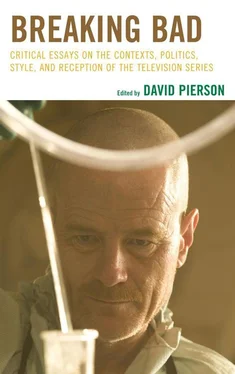This scientific narcissism is certainly a minor symptom of a mad doctor syndrome. As prescribed by mad science tradition, hubris goes beyond control and begins to act against the interest of the individual (Skal 1998). Walter seems here to share the same hubris as an epic hero renowned for his intelligence. Leaving Polyphemus’ cave, Ulysses could not resist from telling the Cyclops that his real name was not Nobody, hence exposing himself and his comrades to danger.
The artful Odysseus cannot do otherwise: as he flees, while still under the sphere controlled by the rock-hurling giant, he not only mocks Polyphemus but reveals to him his true name and origin, as if the primeval world still had such power over Odysseus, who always escaped only by the skin of his teeth, that he would fear to become Nobody again if he did not reestablish his own identity by means of the magical word which rational identity had just superseded. (Horkheimer and Adorno 2002, 53)
This fear to “become Nobody again” perfectly applies to Walter White’s case. In “Buyout” (8/19/12) Walt speaks frankly with Jesse. He tells him that his wife has just said that she is waiting for his cancer to come back; that Gray Matter, the company he has left for dimes, has presently a billion dollar turnover. It is no longer a question of family or money, but building the business into an empire. Family seems to have acted ever since as a cover for his now declared hubris. [5] The fifth season’s strong shift in White’s characterization does not cancel the interpretation that can be made of the first four seasons. An analysis of a TV series that spreads along six years can legitimately take as its corpus the whole series, one single season or even one or more single episodes.
Scientific hubris has become criminal hubris. Walter White does not just want to produce his blue meth but to build an industry as successful and remunerative as Gray Matter. In “Gliding Over All” (9/2/12) Skyler leads Walter to the garage where his illegal incomes are stocked. She tells him that they will never be able to spend all that cash. If Walt’s rational ambition is to leave money to his family, that is far too much. Faced with mountains of dollars the complete irrationality of his actions is apparently evident even to Walter. Other than being loads of money it is a symbol of excess, a manifest revelation of Walter White’s ultimate hubris.
The turning point comes in the episode, “Crazy Handful of Nothin” (3/2/08). Walter White has just shaved his head to prevent the hair loss that is the consequence of chemotherapy. He now has a goatee. He sits a few seconds in his car in meditation. Then he grabs a pack of crystals and moves in the direction of a building painted with graffiti, with small groups of gangster-looking men chatting in front. That is the headquarters of Tuco, the local drug boss. The camera, positioned inside the building, frames Walt in medium shot. We see his silhouette through two kinds of colored windows, passing from yellow to red. He advances again into a yellow background, as though he was going back and forth from risk to danger. Walter asks a gang member to see Tuco. The hand-held camera trembles. Walt stares at a surveillance camera. We see him through its cold lenses. A gang member body searches Walt and takes the crystals. The product brought in by Walter is now analyzed by Tuco. The camera finally follows Walter as he enters Tuco’s room. A reverse-shot shows him advancing with resolution. Tuco asks him who he is and Walt replies, “Heisenberg.”
Werner Heisenberg (1901-1976) is the German theoretical physicist awarded with the Nobel Prize in 1932 “for the creation of quantum mechanics.” [6] Please see http://www.nobelprize.org/nobel_prizes/physics/laureates/1932/index.html .
His name is tied to the uncertainty principle. The choice of the Heisenberg criminal name is full of consequences. This alias acts like a spoiler that provides an interpretative frame for Walter White’s actions. Tuco asks Walter what he wants. The audacious answer is 50,000 dollars. He has entered with belligerent intentions into the headquarters of a dangerous criminal. To be even more convincing he makes use of an explosive, blowing up Tuco’s office. The crystals were not meth but fulminated mercury. The transformation of Walter White into Heisenberg undergoes several changes in look and attitude. Walter White’s choice of Heisenberg’s name can surely be attributed to his will to wear the mask of a revolutionary scientific genius. But the name he picks is Heisenberg, not Newton, Mendeleev, Tesla, or Einstein. There are at least five main applications of Heisenberg’s figure and his notorious uncertainty principle that can give an explanation for such an adoption. The first can be applied to the character’s conscious or unconscious intent, while the other four are principally attributes of the film narrative and its connotative strategies.
As a first element it is interesting to note how the announcement of the criminal name is made in a controlled context, under the gaze of a video surveillance camera, an angle “synecdochic of our time” (Tziallas 2010, 17; Lyon 2006). White and associates also later (“Live Free or Die” 7/15/12) will have trouble with the surveillance regime. They will have to destroy the video data stored in Fring’s computer, now in the possession of the DEA. The surveillance camera is a symptom of control, of the captivity of Walter’s existence. Life events forbid Walter to express his talent. The choice of the Heisenberg name is an exit strategy. Video surveillance can be compared to scientific scrutiny in its aim to record reality and render it objective. Heisenberg’s principle unsettles it all. Reality escapes, hiding data while showing another. As with a microscope, the surveillance camera cannot record everything. Heisenberg’s uncertainty offers an escape from the ideal of transparency and predictability of the surveillance regime. The name of Heisenberg is a guarantee of the complexity of reality. The disciplinary institutions that pretend to be in control cannot have total access to the truth of human lives. The observed subject has traits that make him/her ontologically impossible to be scrutinized in all of his/her intentions and will. Even after being checked and body-searched, Walter is able to introduce explosives in Tuco’s headquarters. There is a misinterpretation in the observation of the crystals (not meth but fulminated mercury) that Walt is carrying with him. Walter White, now Heisenberg, manifests his unpredictability.
A second point is related to the ‘political’ doubts raised by Werner Heisenberg’s behavior during the Second World War. When, in “Negro y Azul” (4/19/09), Walter White has a meeting with Jesse’s pals and dealers at the National Atomic Museum and introduces himself as Heisenberg, some strong and perturbing resonances come to mind. Real Heisenberg’s participation in the development of the national-socialist atomic project is one of the most debated themes in the history of science. [7] See Cassidy 2009. For a synthesis of the different interpretations of Heisenberg’s contribution to Nazi research see Landsman 2002. This topic is also the subject of Michael Frayn’s successful play Copenhagen (1998).
As the plaque in the living room showed in “Pilot,” Walter White worked at Los Alamos. We also know that he was employed at the Sandia National Laboratory, dedicated to weapon research and nuclear science. Walter White is for two seasons the scientist in residence of Fring’s drug industry, manufacturing a drug that causes psychological and physical harm to masses of people. Political naivety or an apolitical attitude become political guilt.
Thirdly, Werner Heisenberg put an end to the concept that science is the “attempt to extract order from confusion” (Lindley 2008, 1). With Heisenberg, science got to admit ambivalence. Debating with his mentor Niels Bohr, the young German physicist resolved to call his principle “uncertainty.” There are variables that an experimenter cannot measure at the same time. If he gets to describe the behavior of one, the second fades. The more precise you get to measuring one aspect, the farther you will find yourself from the other. “Uncertainty” does not mean that a measurement cannot be precise or that science has to submit to chaos. It reveals the necessity to choose between obtaining knowledge about one feature over another—this is what Bohr calls the “principle of complementarity” (see Gilmore 1995, 47). A scientist has to face the impossibility of being in full mastery of his variables and their effects. He can control some determinations of his experiment, but others will remain uncertain. Walter White could not even remotely predict that the actions (to let a young girl die) carried out in episode “Phoenix” (5/24/09) would lead him to be involved in the collision of two airplanes and the death of 167 people in “ABQ” (5/31/09).
Читать дальше












